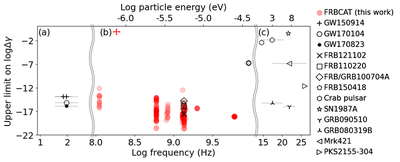 Image credit: [InformiguelCarreño (Own work) [CC BY-SA 4.0], via Wikimedia Commons]
Image credit: [InformiguelCarreño (Own work) [CC BY-SA 4.0], via Wikimedia Commons]
Einstein’s general relativity is the basis of modern astronomy and astrophysics. Therefore, testing the validity of basic assumptions made in general relativity is significant. One of the basic assumptions of general relativity is the so-called ‘Einstein’s weak equivalence principle (WEP)’. WEP means that speeds of lights with different frequencies are exactly the same in a vacuum. If WEP is violated, the speeds of lights would be slightly different for different frequencies, resulting in an arrival time lag between different frequencies. How can we accurately measure such a time lag?
I propose a new method to accurately measure the time lag between different frequencies using fast radio bursts (FRBs). FRBs are millisecond pulses in radio coming from distant galaxies. The long distances to FRBs and their short timescales provide an ideal laboratory to strongly constrain the hypothetical time lag.
If WEP is violated (i.e., the speeds of lights are different for different frequencies in a vacuum), such violation has to be within the observational uncertainty of FRB’s arrival time. This is because we do not see any significant time lag of the FRB emission using current radio telescopes after removing a plasma effect that causes an additional time lag. Therefore, we propose to use the observational uncertainty of FRB’s arrival time to strongly constrain the WEP violation.

This project is based on the following publication.
Tetsuya Hashimoto, Tomotsugu Goto, Daryl Joe D. Santos, Simon C.-C. Ho, Ece Kilerci-Eser, Tiger Y.-Y. Hsiao, Yi Hang Valerie Wong, Alvina Y. L. On, Seong Jin Kim, and Ting-Yi Lu, 'Upper limits on Einstein's weak equivalence principle placed by uncertainties of dispersion measures of fast radio bursts' , accepted for publication in accepted for publication in Physical Review D, (2021).
Please see also
Kaustubha Sen, Tetsuya Hashimoto, Tomotsugu Goto, Seong Jin Kim, Bo Han Chen, Daryl Joe D. Santos, Simon C. C. Ho, Alvina Y. L. On, Ting-Yi Lu, and Tiger Y.-Y. Hsiao, 'Constraining violations of the Weak Equivalence Principle Using CHIME FRBs' , accepted for publication in Monthly Notices of the Royal Astronomical Society, (2021).
This paper was featured by ‘Medium’, 'Testing Einstein’s Work Using Observations of Fast Radio Bursts' .